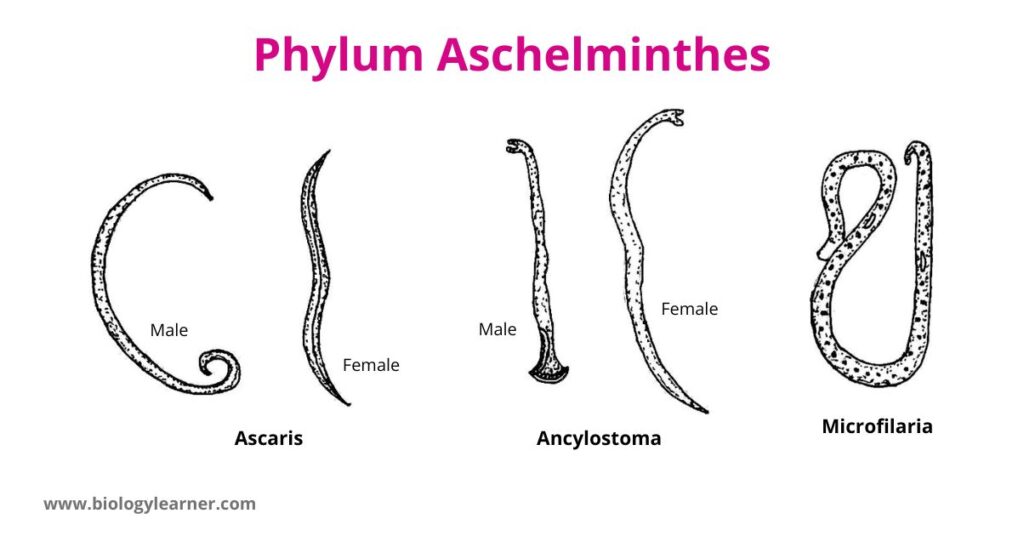Aschelminthes is considered a superphylum, which includes many phyla. The term Aschelminthes was first introduced by Grobben in 1910.
Earlier in 1859, Gegenbour was named Nemathelminthes for this phylum. So, the Phylum Aschelminthes is also known as the phylum Nemathelminthes or the phylum Nematoda.
The Greek words– “Asko = bladder and Helminthes = worm“
There are about 15000 known species of this group. The animals are free-living and parasitic. The free-living forms are usually microscopic.
Definition of Aschelminthes
Aschelminthes are a group of unsegmented worm-like cylindrical organisms having pseudocoelom, epidermal nerve cords, a distinct digestive system with the mouth, and containing a thick cuticular body wall.

Characteristics of Aschelminthes
- The body is a long cylindrical unsegmented thread-like. They are length can vary from 1mm to 50 mm long.
- Bilaterally symmetrical triploblastic body. The Organs are formed in the body.
- There are pseudocoelom present in the body.
- The alimentary canal is straight and complete with a distinct mouth.
- The respiratory system and circulatory system are absent.
- The body wall contains only longitudinal muscles.
- Body covered with a layered cuticle.
- The excretory system consists of a pair of lateral excretory ducts.
- They have epidermal nerve cords with sense organs in the body.
- They are dioecious with separate male and female forms.
- Reproduction occurs by sexual methods.
- Most animals are parasitic to other animals and plants. some forms are free-living in this phylum.
- Some species of this phylum are parasitic on humans (Ascaris, Loa loa).
Identification Characters
- Body structure: Their bodies are unsegmented and cylindrical.
- Pseudocoelom: They have pseudocoelom in the body. There is no mesoderm in the body cavity.
- Muscular system: Advanced types of the muscular system and consists of longitudinal and round muscle tissues.
- Body membrane: Body covered with a layered cuticle.
- Digestive system: In the phylum Aschelminthes, the digestive system is simple. A complete alimentary canal is present.
Examples
Some common examples of phylum Aschelminthes are Ascaris, Wuchereria, Nectonema, Ancylostoma, Gordius, Priapulus, Limnias, Chaetonota, etc.
Classification of Aschelminthes
Phylum Aschelminthes is divided into five classes.
The classification followed here is based on L. H. Hyman (1951).
Class 1. Nematoda
- Order 1. Enploidea (e.g., Enoplus)
- Order 2. Dorylaimida (e.g., Dorylamius)
- Order 3. Mermithidae (e.g., Mermis)
- Order 4. Chromadoroidea (e.g., Paracytholamius)
- Order 5. Eurylaimidae (e.g., Plectus)
- Order 6. Monhysteroidea (e.g., Siphonolaimus)
- Order 7. Desmoscalecoidea (e.g., Desmoscolex)
- Order 8. Rhabditoidea (e.g., Diplogaster)
- Order 9. Rhabdiasoidea (e.g., Rhabdias)
- Order 10. Oxyuroidea (e.g., Oxyuris)
- Order 11. Ascaroidea (e.g., Ascaris)
- Order 12. Strongyloidea (e.g., Ancylostoma)
- Order 13. Spiruroidea (e.g., Rictularia)
- Order 14. Dracunculoidea (e.g., Dracunculus)
- Order 15. Filarioidea (e.g., Wuchereria)
- Order 16. Trichuroidea (e.g., Trichuris)
- Order 17. Dioctophymoidea (e.g., Dictyophyme)
Class 2. Nematomorpha
- Order 1. Cordioidea (e.g., Gordius)
- Order 2. Nectonematoidea (e.g., Nectonema)
Class 3. Rotifera
- Order 1. Seisonacea (e.g., Seison)
- Order 2. Budelloidea (e.g., Rotaria)
- Order 3. Monogonontea (e.g., Mytilina)
Class 4. Gastrotricha
- Order 1. Macrodasyoidea (e.g., Macrodasys)
- Order 2. Chaetonotoidea (e.g., Chaetonotus)
Class 5. Kinorhyncha
- Order 1. Homalorhagida (e.g., Trachydemus)
- Order 2. Cyclorhagida (e.g., Echinoderes)

This is really a tremendous website.
Thank you so much! We are thrilled to hear that you enjoy our website. Your feedback means a lot to us!
The contents are masterpiece. you’ve done a great process on this topic!